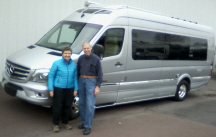
| Canfield Travels |  |
| USA West 2018 #7 Mar 29, 2018 |
Gulf Islands National Seashore
This national seashore stretches 160 miles
along several barrier islands from the panhandle of Florida west to eastern
Mississippi bayous with access by car to several of the Florida islands where
we camped for a night of wind and thunder at Fort Pickens Campground.
Historic Fort Pickens at the western tips of
Santa Rosa Island in Pensacola Bay preserves over a century of American coastal
defensive structures. After the War of 1812 masonry forts like Fort Pickens
were constructed to protect US harbors. These forts were unbeatable when
cannons fired round balls and ships were made of wood.
Fort
Pickens
Gun emplacements
By the end of the Civil War in 1965 rifled
cannon and ironclad warships defeated these harbor defenses. In the 1930’s such
forts were upgraded with new weapons and tactics. The last batteries at Fort
Pickens were built in 1943.
Edison Ford Winter Estates
Many believe that the most important day in Fort Myers history, was March 6, 1885, when Thomas Alva Edison landed in what was then a sleepy tropical village. Unlike some of the lavish, fanciful retreats built by magnets in other Florida cities, the Edison Winter Home illuminates the work as well as the life style of the owner.
The many varieties of bamboo growing in the Ft
Myers area may have enticed Edison to purchase the property in 1885 because it
was the material he used as the filament in early light bulb.
After purchasing the land, he ordered two post-and-beam homes to be pre-cut in Maine and transported by ship to the Ft Myers location and assembled on site by local laborers.
In 1927 Thomas Edison planted a collection of
ficus trees in Ft Myers, Florida along the Caloosahatchee River to research a domestic
source of latex for the production of rubber. The Caloosahatchee River was the
primary means of transportation in this area until the railroad arrived in
1904.
Blooming
azaleas
Orchids in the
palms
Seminole
Lodge with royal palms
Edison phonograph
Henry Ford purchased an adjacent home, “The
Mangoes”, in 1916 which he used about three weeks each year when the Ford
family arrived to help Edison celebrate his birthday in February.
In 1927 Edison, Ford and Firestone formed the Edison Botanic Research Corporation with the purpose of finding a source of latex that could be grown and produced in the US to be used to produce rubber. After laboratory testing over 17,000 plant samples, he eventually concluded the best source was the goldenrod plant.
The banyan tree, a ficus, was one of the
plants tested for rubber research. This tree was planted around 1927 and is one
of the largest in continental US.
Mr. Edison and a single banyan tree Ficus trees
There are over 13 kinds of ficus trees
throughout the Edison and Ford estates.
Sunshine on the Florida west coast
Venice
Beach on the Gulf of Mexico
Warm sunshine in Venice, FL
Following our visit to family - Barbara and Steve Canfield in Venice, then the Dormans Aunt Fran,
Uncle Chuck, and Jackie in Stuart, FL on the east coast –we travel north to
Charleston, SC.